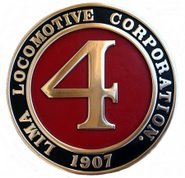 Machinist Alberto Weiss aligns the milling head over one of the valve links to the Diamond and Caldor No. 4 Shay locomotive. Here he uses the indicator on the second hole to tell him when the head is aligned over the hole.
Machinist Alberto Weiss aligns the milling head over one of the valve links to the Diamond and Caldor No. 4 Shay locomotive. Here he uses the indicator on the second hole to tell him when the head is aligned over the hole.At the moment I took the picture, Alberto was five-thousands of an inch off center.
"Now I have the center," said Alberto. To center, he moved the milling machine table "this way" (Alberto motioned side-to-side) and "that way" (front-to-back) until the tool was centered.
Alberto then removed the indicator and inserted the carbide boring tool. He set a towel on top of the valve linkage incase he dropped the heavy tool.
The tool is too valuable (and expensive) to risk breaking it. "This is the only one we have."
Alberto usually makes four or five passes with the boring tool for each hole. This hole only required three passes.
"Until I see the tool doesn't touch any more," explained Alberto. "Then I stop."
Alberto's goal was to make all six holes (two per valve link) equal in diameter.
 "That's fantastic," exclaimed Alberto. "I expected serious problems."
"That's fantastic," exclaimed Alberto. "I expected serious problems.""In the top it hardly took nothing," explained Alberto. "In the bottom the chips were really big."
Sometimes a simple task, like boring out the holes on the valve linkage, goes completely right in the machine shop. It's always a cause for celebration.
The last thing you want to do, said EDWRF president Keith Berry, is to patch up a major blunder, or worst, re-cast the part.
This is the part that tells the locomotive to go this way (pointing forward) or that way (pointing backward) on the first stroke of the engine, said Keith. The first stroke determines which way the steam engine will go.
After that, the engine moves in the direction it was set to go.
"Isn't it amazing that this piece was made 21 years before you were born!" Keith said to Albert.


No comments:
Post a Comment